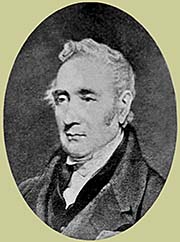 Whilst other areas developed canals to move industrial goods in the days when roads were inadequate for the purpose, the ‘Great Northern Coalfield’ of Northumberland and Durham was the first area in the world to make widespread use of wagonways, primitive railways with wooden tracks, to convey materials from mines and quarries to ports or markets. There are records of wagonways in south-east Northumberland in the seventeenth century, and by the dawn of the nineteenth century a network was already developing. Killingworth can claim a pivotal role in the history of railways, because it was in its West Moor Pit that George Stephenson (right) learned and applied his engineering skills in building locomotives to run on the colliery’s wagonway, and he went on to engineer the Stockton & Darlington Railway (1825) – the first public railway in the world to operate stream-hauled trains on its opening – and the world’s first ‘inter-city’ line between Manchester and Liverpool. Stephenson is honoured as the ‘Father of the Railways’. Whilst other areas developed canals to move industrial goods in the days when roads were inadequate for the purpose, the ‘Great Northern Coalfield’ of Northumberland and Durham was the first area in the world to make widespread use of wagonways, primitive railways with wooden tracks, to convey materials from mines and quarries to ports or markets. There are records of wagonways in south-east Northumberland in the seventeenth century, and by the dawn of the nineteenth century a network was already developing. Killingworth can claim a pivotal role in the history of railways, because it was in its West Moor Pit that George Stephenson (right) learned and applied his engineering skills in building locomotives to run on the colliery’s wagonway, and he went on to engineer the Stockton & Darlington Railway (1825) – the first public railway in the world to operate stream-hauled trains on its opening – and the world’s first ‘inter-city’ line between Manchester and Liverpool. Stephenson is honoured as the ‘Father of the Railways’.
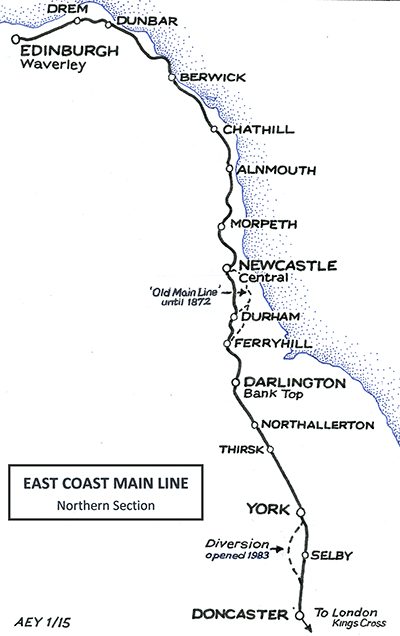 Killingworth station was on the East Coast main line six miles north of Newcastle Central. It possessed one of the large, dignified buildings – some of which are still standing - that graced a number of stations between Newcastle and Berwick. The architect was Benjamin Green, a Newcastle man who, with his father, designed the city’s Theatre Royal and Grey’s Monument. Killingworth station was on the East Coast main line six miles north of Newcastle Central. It possessed one of the large, dignified buildings – some of which are still standing - that graced a number of stations between Newcastle and Berwick. The architect was Benjamin Green, a Newcastle man who, with his father, designed the city’s Theatre Royal and Grey’s Monument.
The village of Killingworth is basically a single street, on a low hill rising above the neighbouring countryside, and it retains something of its historic, rural atmosphere. All around it the landscape has undergone enormous upheavals, not least in the last fifty years. Rich coal reserves lay beneath the fields, and as early as 1373 it was being extracted in the locality. In 1802 Killingworth West Moor Pit opened, south-west of the village, followed by High Pit to the north-east in 1810. In 1804 George Stephenson was taken on as brakesman, in charge of the winding engine that brought miners in and out of the shaft. His ability to repair a defective pumping engine at the High Pit impressed his employers who promoted him to enginewright. Stephenson’s energy and enterprise were unbounded, for not only did he design a miners’ safety lamp (the ‘Geordie’ lamp from which, it is said, Tynesiders derive their nickname) but developed steam locomotive technology. His first successful design, Blucher, operated on the Killingworth Wagonway, and his fame grew as he undertook progressively more prestigious commissions, perhaps the most celebrated being as surveyor of the Stockton & Darlington Railway. The engineering experience of George Stephenson and his son, Robert, enabled the S&D to use steam traction when it opened to passengers in 1825, and they were both key figures in the construction and operation of the world’s first ‘inter-city’ line, between Manchester and Liverpool, opened in 1830. George Stephenson selected the gauge of 4ft 8½in for the lines he built; these dimensions were in use on wagonways in north-east England and were adopted as the ‘standard gauge’ throughout Britain and much of the world. In 1839 George and Robert Stephenson surveyed a route for the Newcastle to Berwick railway which was adopted, with some modifications, and opened in stages in 1847. Fittingly, Killingworth station was on this main line, and it was one of the stations opened with the line. Others - such as its neighbours Forest Hall (south) and Annitsford (north) - were added some years later.
 The Newcastle & Berwick Railway held itself in high esteem and apparently was in no mind to economise, so Killingworth and many other stations were built in a style that was in vogue with architects of country houses. Located close to the level crossing, the two-storey Tudor/Jacobean (‘Jacobethan’) building, on the down (northbound) platform, was constructed of sandstone ashlar. Its projecting wings had raised gables, topped with ball finials, and at platform level each wing was given a canted bay window. Window openings were designed with mullions, and first floor openings at the centre of the platform frontage, and the other elevations, were also given tall gables and finials. Two sets of quadruple chimneystacks soared above the central section of the building. A platform verandah was clasped between the wings, and a pent-roof wooden glazed verandah was added at the north end of the building. On the up platform a waiting shed with a slate, ridged roof faced the main building. The sides and back were of stone, but the front – a later addition by the North Eastern Railway - was glazed with dado panels, some of stone, others of herringbone timber. The Newcastle & Berwick Railway held itself in high esteem and apparently was in no mind to economise, so Killingworth and many other stations were built in a style that was in vogue with architects of country houses. Located close to the level crossing, the two-storey Tudor/Jacobean (‘Jacobethan’) building, on the down (northbound) platform, was constructed of sandstone ashlar. Its projecting wings had raised gables, topped with ball finials, and at platform level each wing was given a canted bay window. Window openings were designed with mullions, and first floor openings at the centre of the platform frontage, and the other elevations, were also given tall gables and finials. Two sets of quadruple chimneystacks soared above the central section of the building. A platform verandah was clasped between the wings, and a pent-roof wooden glazed verandah was added at the north end of the building. On the up platform a waiting shed with a slate, ridged roof faced the main building. The sides and back were of stone, but the front – a later addition by the North Eastern Railway - was glazed with dado panels, some of stone, others of herringbone timber.
The costings of Newcastle & Berwick stations have survived. Those for Killingworth are given below and are representative of a typical station on this line (source: Fawcett 2001):
| |
Main Station Building |
£1,128 18s 9½d |
| |
Waiting Shed Opposite |
£158 0s 1d |
| |
Platforms |
£639 6s 3d |
| |
Coal Depots |
£225 17s 3d |
| |
Office and Weighbridge |
£125 18s 7d |
| |
Walls and Gates |
£80 5s 9d |
| |
Station Fittings (Lamps &c) |
£87 10s 0d |
| |
Wells and Pumps |
£30 12s 2d |
| |
Metalling Roadway |
£88 17s 0d |
| |
Total |
£2,562 6s 11½d |
The station was to receive a standard cast-iron NER footbridge adjacent to the level crossing. Immediately north of the crossing, on the down side, the brick-built hipped-roof signal box, opened on 26 March 1899, was tall enough for the signalmen’s vision not to be obstructed by the footbridge; it replaced an earlier box opened in the early 1870s. Also on the down side, south of the station and just north of the bridge over Great Lime Road, was Killingworth Sidings signal box, which had opened by April 1889. This box controlled the facilities that served Gosforth Racecourse, of which more anon. East of the main line mineral lines diverged, one south-eastward to West Moor Pit and thence to the Killingworth Wagonway, and the other north-eastwards to Burradon Colliery, linking with a network of mineral lines.
The passenger train service from Killingworth in May 1849 in Reid’s Monthly Time Table is shown below.
Up trains: weekdays |
Destination |
Down trains: weekdays |
Destination |
9.50am |
Newcastle |
7.12am |
Berwick |
1.20pm |
Newcastle |
1.43pm |
Berwick |
8.02pm |
Newcastle |
3.51pm |
Berwick |
|
|
6.58pm |
Berwick |
Up trains: Sunday |
Destination |
Down trains: Sunday |
Destination |
9.41am |
Newcastle |
7.27am |
Berwick |
7.57pm |
Newcastle |
6.18pm |
Berwick |
The February 1863 service in Bradshaw:
Up trains: weekdays |
Destination |
Down trains: weekdays |
Destination |
8.57am |
Newcastle |
9.17am |
Berwick |
9.17am (Saturday only) |
Newcastle |
1.37pm |
Berwick |
2.32pm |
Newcastle |
3.47pm (Saturday only) |
Widdrington |
8.16pm |
Newcastle |
6.47pm |
Berwick |
Up trains: Sunday |
Destination |
Down trains: Sunday |
Destination |
8.55am |
Newcastle |
c6.33am (by request) |
Berwick |
c6.36pm (by request) |
Newcastle |
6.35pm |
Berwick |
The location of the station was not convenient for Killingworth village, a mile away, without a direct path or road; neither was there direct access to the West Moor colliery cottages. When the station opened, and until the 1960s, the area north of the station was largely farmland, whilst to the west stood Gosforth House, the late eighteenth century mansion of the Brandling Family, surrounded by their pleasure ground, High Gosforth Park. (The Brandling family had a significant role in railway development, principally south of the Tyne: click Felling 1st for further details.) These features of its hinterland limited the numbers of passengers who used Killingworth station; in 1911 a comparison with its neighbouring stations showed that while Killingworth booked 34,429 passengers, Forest Hall booked 40,491 and Annitsford 49,132. However, Killingworth gained a new source of passengers when, in 1881, the Newcastle races were transferred from the city’s Town Moor to (High) Gosforth Park. The NER racecourse station at Moor End (between Jesmond and South Gosforth) was abandoned, and at Killingworth several sidings for racecourse traffic were added behind the down platform. Killingworth Sidings signal box controlled access to the racecourse facilities, where horse boxes were dealt with, and two platforms were built: an island and a flanking platform at the south-western edge of the sidings. On race days special trains conveyed passengers to the untimetabled ‘Killingworth Sidings Platform’.
In 1882 West Moor Pit closed and eventually the insalubrious rows of miners’ cottages were demolished. Housing development near the station was limited, and from the 1920s frequent buses and trams to Newcastle took business away from Killingworth station.
The North Eastern Railway Time Table dated 1 October 1912 shows a much more frequent service than in 1863, although at irregular intervals.
Up trains: weekdays |
Destination |
Down trains: weekdays |
Destination |
7.30am |
Newcastle |
8.19am |
Beal |
8.23am |
Newcastle |
10.45am |
Alnwick |
9.22am |
Newcastle |
12.55pm |
Morpeth |
11.16am (Sat only) |
Newcastle |
1.48pm |
Alnwick |
11.51am |
Newcastle |
2.44pm |
Morpeth |
2.10pm |
Newcastle |
4.33pm |
Morpeth |
3.35pm (Sat only) |
Newcastle |
6.49pm |
Alnwick |
4.06pm |
Newcastle |
8.53pm |
Alnwick |
6.10pm |
Newcastle |
9.37pm (Sat only) |
Longhirst |
8.07pm |
Newcastle |
11.36pm (Tue, Thu, Sat only) |
Morpeth |
10.14pm |
Newcastle |
|
|
Up trains: Sunday |
Destination |
Down trains: Sunday |
Destination |
8.49am |
Newcastle |
8.18am |
Berwick |
8.40pm |
Newcastle |
2.51pm |
Morpeth |
|
|
6.55pm |
Berwick |
The station passed from NER to LNER ownership at the Grouping of 1923, and the only significant change at the station was the replacement of NER running-in nameboards with LNER ones of wood with metal letters pegged to them. These nameboards were in place until closure of the station. Gas lighting was retained at the station. The train service provided by the LNER in 1937-38 was of similar frequency to that in the 1912-13 timetable.
 In 1924 the Gosforth Park Light Railway was completed as part of the local electric tramway network, linking the Great North Road at Gosforth with the existing tram route to West Moor. The new double-track tramway followed a route through Gosforth Park and passed the racecourse grandstand where the four-track ‘Grand Stand Station’ was provided to handle the race-day crowds. J Joyce in Roads and rails of Tyne & Wear (1985) notes that ‘this delightful sylvan ride savoured of a genuine railway, with embankments, cuttings and bridges, and the “circular tour” from [Newcastle] offering a round trip of about 11 miles for 6d (2½p) was deservedly popular’. Killingworth station was over a mile from the racecourse grandstand, so the tramway offered stiff competition to the railway in conveying race-goers. From 1928 cars ran through the Park only in the summer. The route was reopened after the war for race days in 1946 and 1947. It survives as a track through the park, and the author has fond memories of it as part of the cross-country course used by George Stephenson Grammar School, West Moor, when he was a pupil there in the 1960s. In 1924 the Gosforth Park Light Railway was completed as part of the local electric tramway network, linking the Great North Road at Gosforth with the existing tram route to West Moor. The new double-track tramway followed a route through Gosforth Park and passed the racecourse grandstand where the four-track ‘Grand Stand Station’ was provided to handle the race-day crowds. J Joyce in Roads and rails of Tyne & Wear (1985) notes that ‘this delightful sylvan ride savoured of a genuine railway, with embankments, cuttings and bridges, and the “circular tour” from [Newcastle] offering a round trip of about 11 miles for 6d (2½p) was deservedly popular’. Killingworth station was over a mile from the racecourse grandstand, so the tramway offered stiff competition to the railway in conveying race-goers. From 1928 cars ran through the Park only in the summer. The route was reopened after the war for race days in 1946 and 1947. It survives as a track through the park, and the author has fond memories of it as part of the cross-country course used by George Stephenson Grammar School, West Moor, when he was a pupil there in the 1960s.
Click here for a short film taken on the first tram through Gosforth Park.
A north-to-west curve linking the ‘Coast Circle’ electrified line at Benton with the ECML south of Forest Hall was constructed in 1940, in the early days of World War II, to provide an alternative route north of Newcastle should the strategic Heaton Junction with its locomotive and carriage sheds and extensive sidings be a target for enemy bombs. Some of the trains that called at Killingworth were transferred to this new route operating via Manors North and Benton, rather than Manors East and Heaton. As elsewhere in Britain in this war, local stopping trains were reduced in frequency.
In June 1943 Bradshaw shows the following departures from Killingworth.
Up trains: weekdays |
Destination |
Down trains: weekdays |
Destination |
7.28am |
Newcastle |
7.03am |
Berwick |
8.39am [B] |
Newcastle |
8.46am [B] |
Alnwick |
11.20am |
Newcastle |
1.31pm [B] |
Alnwick |
5.24pm [B] |
Manors North |
2.50pm [B] |
Morpeth |
7.31pm [B] |
Newcastle |
9.51pm [B] |
Alnwick |
Up trains: Sunday |
Destination |
Down trains: Sunday |
Destination |
8.49am |
Newcastle |
7.50am |
Berwick |
7.51pm |
Newcastle |
6.46pm |
Berwick |
In the above table, trains noted [B] travel via Benton. Whilst two morning departures would have been suitable for Killingworth passengers working in Newcastle there was a substantial gap in the down service with no convenient return trains; the 5.00pm Monday-to-Friday departure from Newcastle Central, however, did call at Killingworth’s neighbouring stations of Forest Hall, Annitsford and Cramlington where somewhat larger communities lived close to the stations. In peace time the final LNER timetable (October 1947) showed a service frequency little changed from 1943, but trains no longer travelled via Benton. From 1 January 1948 Killingworth was operated by British Railways’ North Eastern Region, who repainted the nameboards in the striking tangerine livery, but in other respects left the station unchanged.
I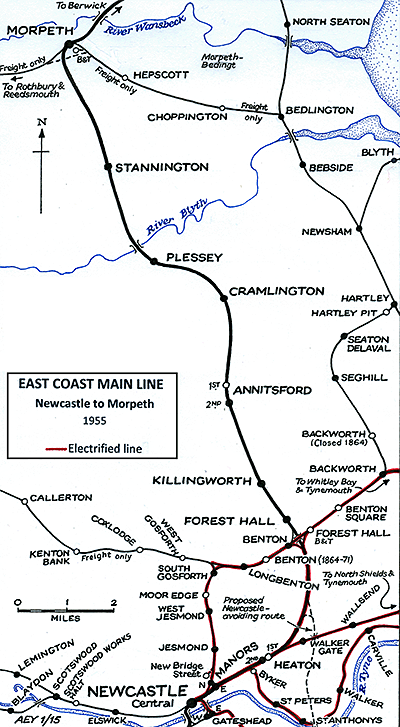 n 1951 only 1,116 passengers were booked. The timetable of summer 1952 introduced a marked reduction in the train frequency at this and the other minor stations on the ECML in Northumberland. Up trains called on weekdays at 8.38am, 11.08 (Saturday only) and 5.37pm with one Sunday departure at 6.33pm, all bound for Newcastle. Down trains called at 7.33am (to Berwick), 12.54pm (Saturdays only, to Alnwick) and 10.16pm (to Alnwick), with a 7.36pm train to Berwick on Sunday. n 1951 only 1,116 passengers were booked. The timetable of summer 1952 introduced a marked reduction in the train frequency at this and the other minor stations on the ECML in Northumberland. Up trains called on weekdays at 8.38am, 11.08 (Saturday only) and 5.37pm with one Sunday departure at 6.33pm, all bound for Newcastle. Down trains called at 7.33am (to Berwick), 12.54pm (Saturdays only, to Alnwick) and 10.16pm (to Alnwick), with a 7.36pm train to Berwick on Sunday.
From June 1954 Killingworth station was closed on Sunday. By summer 1958 only one train called in each direction on Monday-to-Friday, with two on Saturday. On 15 September 1958 Killingworth was one of ten East Coast main line stations in Northumberland to close to passengers. However occasional passenger trains continued to operate to the racecourse platforms until 1959, and Killingworth Sidings signal box closed on 25 February 1962. Goods services were discontinued on 7 June 1965.
After closure to passengers the platform faces on the main line were demolished, which was common practice to prevent them from deteriorating and collapsing onto the rails, and the lamps and running-in nameboards were removed. The buildings on both platforms remained in place, but derelict, for many years. The footbridge was retained for pedestrians to use when the crossing gates were closed, and for a long time the up-platform LNER nameboard, removed from its stanchions, was propped up under the footbridge.
In 1973 the buildings were still standing, but their condition was deteriorating, and they were demolished shortly afterwards. The racecourse sidings were lifted, but their site remained a wasteland for many years. The level crossing gates were replaced with barriers on 21 July 1974 and, having been demoted to a gate box, Killingworth station signal box was decommissioned on 29 January 1978; thereafter the crossing was monitored by CCTV from Benton and the base of the box was retained as a relay room. A housing development (Sharon Close) and its car park now occupy the site of Killingworth racecourse platforms and sidings, and trees grow where the main line platforms once stood. Where the mineral lines to the collieries once ran there is a small industrial estate.
 Shortly before it closed, two small new residential estates were built in West Moor within a few minutes’ walk of Killingworth station, and from 1963 Northumberland County Council developed a new town, officially known as Killingworth Township, between the station and Killingworth Village. It spread across 760 acres of former mine workings, mineral lines, and farmland of indifferent quality and now provides homes for over 15,000 people. It transformed the landscape not only by its sheer extent, but by including a lake (which was generally liked) as well as blocks of concrete, deck-access flats and the concrete Citadel shopping centre (which were generally disliked). The landscape changed again in the 1980s with the demolition of the flats and shopping centre. In spite of this surge in local population Killingworth station has not reopened. It is some way from the centre of the new town, and bus services are plentiful, some providing access to Four Lane Ends park-and-ride station on the Tyne & Wear Metro system. Moreover the reintroduction of local stopping trains to serve Killingworth (and possibly Forest Hall and Annitsford too) would interfere with the frequent high-speed services between Newcastle and Edinburgh. At present it seems that Killingworth will remain a ‘lost station’. Shortly before it closed, two small new residential estates were built in West Moor within a few minutes’ walk of Killingworth station, and from 1963 Northumberland County Council developed a new town, officially known as Killingworth Township, between the station and Killingworth Village. It spread across 760 acres of former mine workings, mineral lines, and farmland of indifferent quality and now provides homes for over 15,000 people. It transformed the landscape not only by its sheer extent, but by including a lake (which was generally liked) as well as blocks of concrete, deck-access flats and the concrete Citadel shopping centre (which were generally disliked). The landscape changed again in the 1980s with the demolition of the flats and shopping centre. In spite of this surge in local population Killingworth station has not reopened. It is some way from the centre of the new town, and bus services are plentiful, some providing access to Four Lane Ends park-and-ride station on the Tyne & Wear Metro system. Moreover the reintroduction of local stopping trains to serve Killingworth (and possibly Forest Hall and Annitsford too) would interfere with the frequent high-speed services between Newcastle and Edinburgh. At present it seems that Killingworth will remain a ‘lost station’.
On a positive note: the legacy of the Stephenson family, their family home at Dial Cottage on Great Lime Road, survives as a museum; and the name lives on, both in the ‘Station Hotel’ and in the Premier Alliance Northern Division Killingworth Station FC, which is sponsored by the hotel.
Click here for a brief history of the East Coast Main Line
in Northumberland.
BIBLIOGRAPHY:
- Addyman, John F ‘NER standard cast iron footbridge’ in North Eastern Express No.74 February 1979 (NERA)
- Addyman, John F (Editor) A history of the Newcastle & Berwick Railway (North Eastern Railway Association, 2011) – especially Chapter 5 ‘The buildings’ by Bill Fawcett
- Biddle, Gordon Victorian stations (David & Charles, 1973)
- Biddle, Gordon Britain’s historic railway buildings (Oxford University Press, 2003)
- Elliott, W G Bygone days of Longbenton, Benton, Forest Hall, West Moor, Killingworth, Palmersville and Benton Square (Author, 2000)
- Fawcett, Bill A history of North Eastern Railway architecture Vol 1: The Pioneers (North Eastern Railway Association 2001)
- Young, Alan Railways in Northumberland (Martin Bairstow, 2003)
- Young, Alan Lost stations of Northumberland & Durham (Silver Link 2011)
See other ECML stations:Tweedmouth, Scremerston, Goswick, Beal, Smeafield, Crag Mill, Belford, Lucker,
Newham, Fallodon, Little Mill, Christon Bank,
Longhoughton, Lesbury, Warkworth, Longhirst, Ashington Colliery Junction, Morpeth, Stannington, Plessey, Annitsford (1st), Annitsford (2nd), Killingworth, Forest Hall, Heaton (2nd), Heaton (1st), Durham, Croft Spa, Eryholme, Otterington, Alne & Tollerton |

old1.jpg)

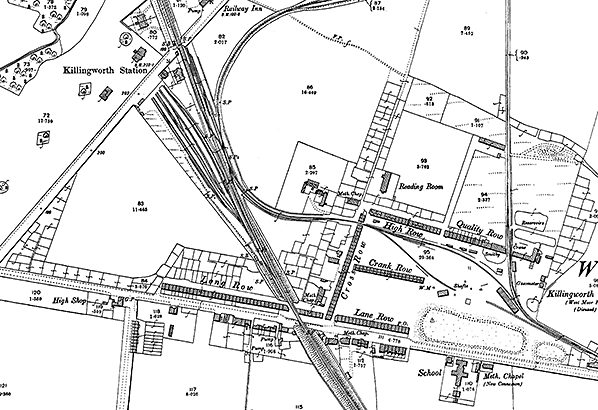
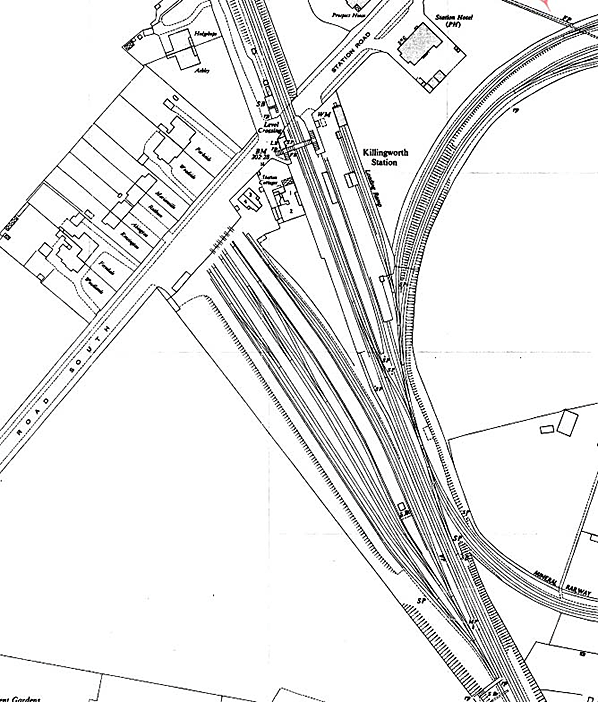
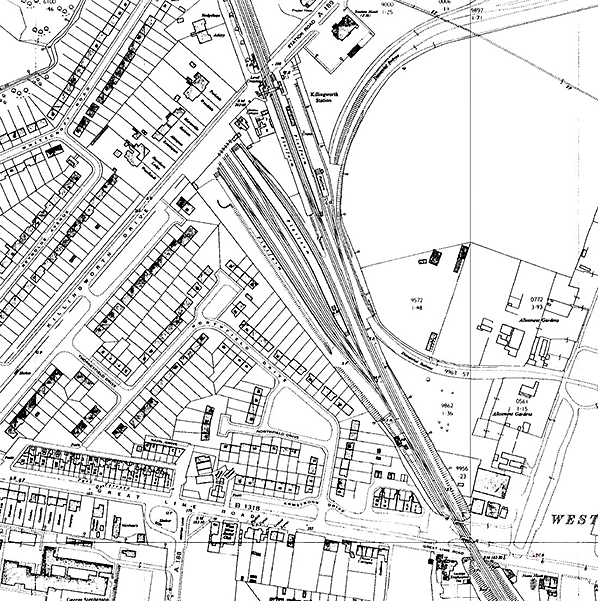
old3.jpg)
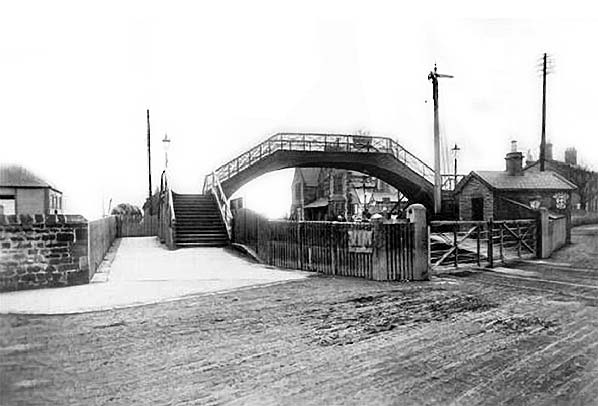
old2.jpg)
old4.jpg)
old5.jpg)
 Whilst other areas developed canals to move industrial goods in the days when roads were inadequate for the purpose, the ‘Great Northern Coalfield’ of Northumberland and Durham was the first area in the world to make widespread use of wagonways, primitive railways with wooden tracks, to convey materials from mines and quarries to ports or markets. There are records of wagonways in south-east Northumberland in the seventeenth century, and by the dawn of the nineteenth century a network was already developing. Killingworth can claim a pivotal role in the history of railways, because it was in its West Moor Pit that George Stephenson (right) learned and applied his engineering skills in building locomotives to run on the colliery’s wagonway, and he went on to engineer the Stockton & Darlington Railway (1825) – the first public railway in the world to operate stream-hauled trains on its opening – and the world’s first ‘inter-city’ line between Manchester and Liverpool. Stephenson is honoured as the ‘Father of the Railways’.
Whilst other areas developed canals to move industrial goods in the days when roads were inadequate for the purpose, the ‘Great Northern Coalfield’ of Northumberland and Durham was the first area in the world to make widespread use of wagonways, primitive railways with wooden tracks, to convey materials from mines and quarries to ports or markets. There are records of wagonways in south-east Northumberland in the seventeenth century, and by the dawn of the nineteenth century a network was already developing. Killingworth can claim a pivotal role in the history of railways, because it was in its West Moor Pit that George Stephenson (right) learned and applied his engineering skills in building locomotives to run on the colliery’s wagonway, and he went on to engineer the Stockton & Darlington Railway (1825) – the first public railway in the world to operate stream-hauled trains on its opening – and the world’s first ‘inter-city’ line between Manchester and Liverpool. Stephenson is honoured as the ‘Father of the Railways’. Killingworth station was on the East Coast main line six miles north of Newcastle Central. It possessed one of the large, dignified buildings – some of which are still standing - that graced a number of stations between Newcastle and Berwick. The architect was Benjamin Green, a Newcastle man who, with his father, designed the city’s Theatre Royal and Grey’s Monument.
Killingworth station was on the East Coast main line six miles north of Newcastle Central. It possessed one of the large, dignified buildings – some of which are still standing - that graced a number of stations between Newcastle and Berwick. The architect was Benjamin Green, a Newcastle man who, with his father, designed the city’s Theatre Royal and Grey’s Monument. The Newcastle & Berwick Railway held itself in high esteem and apparently was in no mind to economise, so Killingworth and many other stations were built in a style that was in vogue with architects of country houses. Located close to the level crossing, the two-storey Tudor/Jacobean (‘Jacobethan’) building, on the down (northbound) platform, was constructed of sandstone ashlar. Its projecting wings had raised gables, topped with ball finials, and at platform level each wing was given a canted bay window. Window openings were designed with mullions, and first floor openings at the centre of the platform frontage, and the other elevations, were also given tall gables and finials. Two sets of quadruple chimneystacks soared above the central section of the building. A platform verandah was clasped between the wings, and a pent-roof wooden glazed verandah was added at the north end of the building. On the up platform a waiting shed with a slate, ridged roof faced the main building. The sides and back were of stone, but the front – a later addition by the North Eastern Railway - was glazed with dado panels, some of stone, others of herringbone timber.
The Newcastle & Berwick Railway held itself in high esteem and apparently was in no mind to economise, so Killingworth and many other stations were built in a style that was in vogue with architects of country houses. Located close to the level crossing, the two-storey Tudor/Jacobean (‘Jacobethan’) building, on the down (northbound) platform, was constructed of sandstone ashlar. Its projecting wings had raised gables, topped with ball finials, and at platform level each wing was given a canted bay window. Window openings were designed with mullions, and first floor openings at the centre of the platform frontage, and the other elevations, were also given tall gables and finials. Two sets of quadruple chimneystacks soared above the central section of the building. A platform verandah was clasped between the wings, and a pent-roof wooden glazed verandah was added at the north end of the building. On the up platform a waiting shed with a slate, ridged roof faced the main building. The sides and back were of stone, but the front – a later addition by the North Eastern Railway - was glazed with dado panels, some of stone, others of herringbone timber. In 1924 the Gosforth Park Light Railway was completed as part of the local electric tramway network, linking the Great North Road at Gosforth with the existing tram route to West Moor. The new double-track tramway followed a route through Gosforth Park and passed the racecourse grandstand where the four-track ‘Grand Stand Station’ was provided to handle the race-day crowds. J Joyce in Roads and rails of Tyne & Wear (1985) notes that ‘this delightful sylvan ride savoured of a genuine railway, with embankments, cuttings and bridges, and the “circular tour” from [Newcastle] offering a round trip of about 11 miles for 6d (2½p) was deservedly popular’. Killingworth station was over a mile from the racecourse grandstand, so the tramway offered stiff competition to the railway in conveying race-goers. From 1928 cars ran through the Park only in the summer. The route was reopened after the war for race days in 1946 and 1947. It survives as a track through the park, and the author has fond memories of it as part of the cross-country course used by George Stephenson Grammar School, West Moor, when he was a pupil there in the 1960s.
In 1924 the Gosforth Park Light Railway was completed as part of the local electric tramway network, linking the Great North Road at Gosforth with the existing tram route to West Moor. The new double-track tramway followed a route through Gosforth Park and passed the racecourse grandstand where the four-track ‘Grand Stand Station’ was provided to handle the race-day crowds. J Joyce in Roads and rails of Tyne & Wear (1985) notes that ‘this delightful sylvan ride savoured of a genuine railway, with embankments, cuttings and bridges, and the “circular tour” from [Newcastle] offering a round trip of about 11 miles for 6d (2½p) was deservedly popular’. Killingworth station was over a mile from the racecourse grandstand, so the tramway offered stiff competition to the railway in conveying race-goers. From 1928 cars ran through the Park only in the summer. The route was reopened after the war for race days in 1946 and 1947. It survives as a track through the park, and the author has fond memories of it as part of the cross-country course used by George Stephenson Grammar School, West Moor, when he was a pupil there in the 1960s. n 1951 only 1,116 passengers were booked. The timetable of summer 1952 introduced a marked reduction in the train frequency at this and the other minor stations on the ECML in Northumberland. Up trains called on weekdays at 8.38am, 11.08 (Saturday only) and 5.37pm with one Sunday departure at 6.33pm, all bound for Newcastle. Down trains called at 7.33am (to Berwick), 12.54pm (Saturdays only, to Alnwick) and 10.16pm (to Alnwick), with a 7.36pm train to Berwick on Sunday.
n 1951 only 1,116 passengers were booked. The timetable of summer 1952 introduced a marked reduction in the train frequency at this and the other minor stations on the ECML in Northumberland. Up trains called on weekdays at 8.38am, 11.08 (Saturday only) and 5.37pm with one Sunday departure at 6.33pm, all bound for Newcastle. Down trains called at 7.33am (to Berwick), 12.54pm (Saturdays only, to Alnwick) and 10.16pm (to Alnwick), with a 7.36pm train to Berwick on Sunday. Shortly before it closed, two small new residential estates were built in West Moor within a few minutes’ walk of Killingworth station, and from 1963 Northumberland County Council developed a new town, officially known as Killingworth Township, between the station and Killingworth Village. It spread across 760 acres of former mine workings, mineral lines, and farmland of indifferent quality and now provides homes for over 15,000 people. It transformed the landscape not only by its sheer extent, but by including a lake (which was generally liked) as well as blocks of concrete, deck-access flats and the concrete Citadel shopping centre (which were generally disliked). The landscape changed again in the 1980s with the demolition of the flats and shopping centre. In spite of this surge in local population Killingworth station has not reopened. It is some way from the centre of the new town, and bus services are plentiful, some providing access to Four Lane Ends park-and-ride station on the Tyne & Wear Metro system. Moreover the reintroduction of local stopping trains to serve Killingworth (and possibly Forest Hall and Annitsford too) would interfere with the frequent high-speed services between Newcastle and Edinburgh. At present it seems that Killingworth will remain a ‘lost station’.
Shortly before it closed, two small new residential estates were built in West Moor within a few minutes’ walk of Killingworth station, and from 1963 Northumberland County Council developed a new town, officially known as Killingworth Township, between the station and Killingworth Village. It spread across 760 acres of former mine workings, mineral lines, and farmland of indifferent quality and now provides homes for over 15,000 people. It transformed the landscape not only by its sheer extent, but by including a lake (which was generally liked) as well as blocks of concrete, deck-access flats and the concrete Citadel shopping centre (which were generally disliked). The landscape changed again in the 1980s with the demolition of the flats and shopping centre. In spite of this surge in local population Killingworth station has not reopened. It is some way from the centre of the new town, and bus services are plentiful, some providing access to Four Lane Ends park-and-ride station on the Tyne & Wear Metro system. Moreover the reintroduction of local stopping trains to serve Killingworth (and possibly Forest Hall and Annitsford too) would interfere with the frequent high-speed services between Newcastle and Edinburgh. At present it seems that Killingworth will remain a ‘lost station’.
 Home Page
Home Page